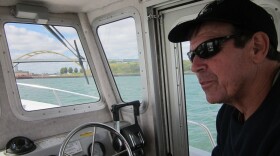Phytoplankton – the algae that are food for plankton which in turn feed fish – are behaving strangely. They’re surrounded by a nutrient they need to grow. But for some reason, they’re not using it.
The puzzle has big implications for how scientists think about the Great Lakes’ future in a warming world.
Tiny creatures
It’s a crisp sunny morning on the St. Lawrence River. All of the Great Lakes’ water flows through here on its way to the ocean.
Michael Twiss is leaning over the edge of his research boat, his face just a couple inches from the water’s surface. He swishes the water like he’s sniffing fine wine.
“Yup, there’s a fall bloom going on, because we’re at the end of the summer.”
DAVID: “That’s those little sparkly crystals in the water?”
“Yes, that’s what you’re seeing right there. Those are algae.”
Twiss is a limnologist at Clarkson University. He studies algae like this – the bottom of the food web that sustains the Great Lakes’ fishery.
The algae – also called phytoplankton – like to eat nitrate – nitrogen plus oxygen. In all of Great Lakes, there’s loads of nitrate. But get this. Twiss says they’re not eating it.
"The mystery is akin to being at a free smorgasbord and ordering out for pizza. You're going to have to wait longer to get your food, and you're going to have to pay for it."
“The mystery is akin to being at a free smorgasbord and ordering out for pizza. You’re going to have to wait longer to get your food, and you’re going to have to pay for it. So why aren’t they using this nutrient that’s available to them?”
Why should we care what the critters eat?
There are two reasons why this matters. First, if they ate more nitrate, they’d grow and become more food for fish.
Second, the algae would also eat more carbon from the atmosphere, just like trees do through photosynthesis.
“These lakes, which hold 20% of the world’s fresh water, play an important role in sequestering carbon and taking it out of the atmosphere and into the bottom of the lakes. That’s a natural process.”
In fact, the Great Lakes do a better job proportionally at sucking up carbon than the ocean does.
So, if only we could get those phytoplankton to eat more nitrate, we’d have more fish and we’d alleviate climate change at the same time, right?
Not so fast. Climate change cuts both ways.
Andy Bramburger is a researcher at the St. Lawrence River Institute in Cornwall, Ontario. He says the warmer climate is changing the kind of algae in the Lakes – from the kind that’s good for fish to the kind that causes toxic algal blooms and kills fish.
“With climate change and with these fluctuations in temperatures, and the rapid warming we’ve been seeing in the early parts of the spring and summer in recent years, we are tipping the balance in favor of algae that are not favorable to our use of waterways,” he says.
The detective cracks the case... a little
Michael Twiss recently made a tiny breakthrough in the phytoplankton mystery. Phytoplankton also need trace metals to eat the nitrate. So when he sprinkled the trace metal molybdenum into water samples – poof – the algae feasted like it was a smorgasbord.
Twiss’ hypothesis is that invasive species like zebra mussels have sucked too many metals and other nutrients out of the water. Twiss says it may be a new paradigm.
“A shift in the way the ecosystem is operating, and it’s up to us to understand how it operates so we can predict what will happen in the future, and so we can manage for change, particularly climate change.”
To protect our clean waters, our fishery, and our relationship with the Great Lakes in the face of climate change, scientists will have to puzzle out the mysteries at the bottom of the food web.





